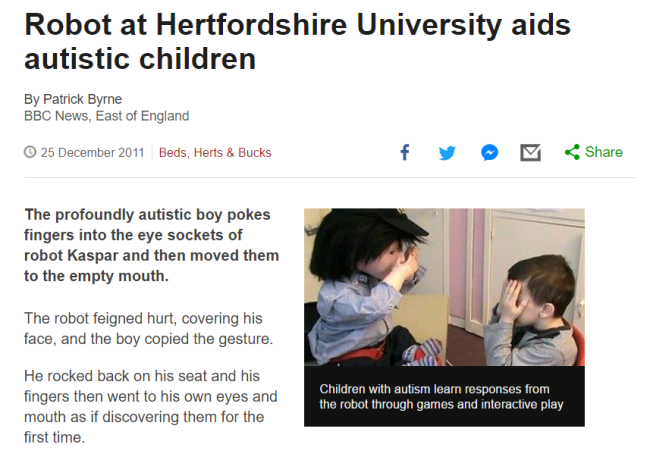I was reading this article about how, in this digital day and age, social robots could be designed to be child-friendly with special functions to serve educational purposes. A social robot is a robot specifically designed to interact with humans. It got me thinking about how social robots work and the impacts of their interactions with children. In the article, Vogt, de Haas, de Jong, Baxter, and Krahmer (2017), emphasize that the robot is at its most effective when it is introduced as a peer and fellow learner, but having adult-like interaction strategies. It is important that the robot be adaptive to the needs of each individual child, thus staying within the Zone of Proximal Development (Vogt et al, 2017).
While this was the first I had heard of “social robots”, apparently they have been around for at least a few years now. In 2011, BBC published an article about how researchers are finding that social robots are helping children with profound autism learn social and communication skills through games and interactive play. The social robots are a means for the children to explore, observe, and engage with their environment without any negative reactions or responses (BBC, 2014).
I did some more researching and found Robots4Autism, a program that uses purpose-built humanoid robots to deliver curriculum using evidence-based best practices for building social and behavioral skill development in a 1:1 setting. The robot, Milo, can smile, laugh, walk, and speak, giving children the opportunity to practice and develop their socio-emotional and communication skills. I’m curious as to how using a robot would play out in an inclusive educational setting, and if use of the robot could be integrated into a constructivist curriculum.
However, humanoids are not the only kind of child-friendly robot out there. In the video below, we can see Tega, a squishy, cartoon-like, smart-phone based social robot, designed by MIT’s Personal Robotics Lab. Tega has already been put to work teaching Spanish to preschoolers!
What do you all think about using social robots in an early childhood educational context? Would you use robots like Milo and Tega in your work with young children? Do you think children would have a preference between the two robots?
I, myself would have loved having Tega as a tool when I was doing my literacy intervention placement with the Toronto District School Board. She seems adorably interactive!
(Image credit: BBC News)

Wow, this seems to be the most fascinating thing I’ve ever heard of and I really mean it! I never in my entire years of undergrad have come across Social Robots! After reading your blog I find it that social robots are a brilliant tool to help children with Autism, however I was curious and I’m wondering are these Social Robots only used with children with Profound Autism or does it apply to all children?
LikeLike
Overall, to answer your question I strongly feel that Social Robots are a great invention for early childhood education as it is age-appropriate, user-friendly, and engaging to operate. Personally speaking, if I was a child myself I would love waking up and going to school to interact with a robot throughout the day! Most important of all, the Social Robot would help me stay focused, and it would definitely help me raise my social skills as I will consistently communicate back and forth with the Social Robot. However, if there was no Social Robot I feel that many children would slack off or get bored of school because there’s nothing there to motivate them. Personally, these are just my direct opinions and I’m happy to discover that these inventions exist in our school systems today! Again, I feel that today we are doing a lot better accomodating different children with different needs than our past school systems have done.
LikeLike
Hi Iqra,
Thank you so much for your insightful comments!
Actually, social robots are currently being used with children with all kinds of developmental abilities and needs. While the BBC study was specific to children with profound autism, the Robots4Autism program states that their robots are designed for children with various ranges of ASD. The Tega robot is currently being used to teach neurotypical children a second language, and I’m sure she will be doing a lot more soon!
I think we will be seeing more and more use of robots and AIs as educational tools, and it will definitely be interesting to observe how our generation of teachers and educators will adapt to this.
LikeLike
Hi Fatima,
Your post was the first introduction I had to social robots as well! To answer your question, I feel like they would be a great addition in early childhood contexts, especially for children who are still developing their communication skills or even children who are English language learners. Social robots would also add a technological component to the classroom, which is always a benefit!
LikeLike